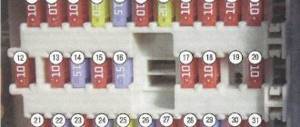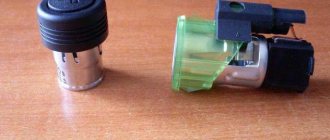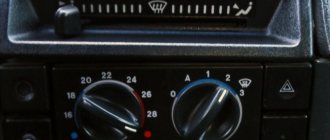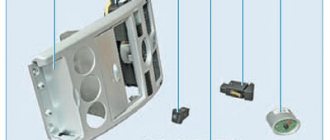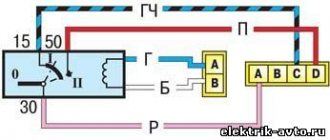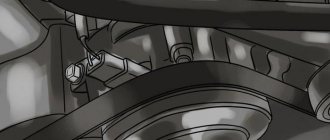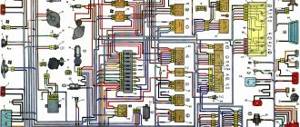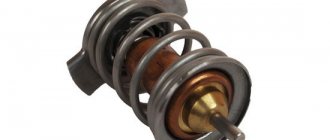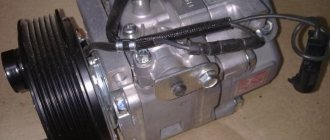Fuse
A fuse is an electrical switching device designed to protect electrical circuits by breaking the circuit due to its destruction or shutting down when a current flowing through it exceeds the permissible values.
Fuses come in several types and are used in all electrical circuits to protect vehicles from short circuits (short circuits). They are classified according to the rated current of the fuse link.
The fuse link is the part of the fuse that is destroyed by electrical current.
The rated current is the current of the fuse at which the fuse-link will operate indefinitely and will not be subject to destruction.
Operating principle of the fuse
When using a fuse in an electrical circuit, the operating current passing through the fuse does not exceed its rated current - this is its normal operation. But as soon as a current appears in the electrical circuit that exceeds the safe permissible values in this circuit, regulated by the fuse, the fuse-link, under the influence of a current exceeding the rated current of the insert, begins to melt and collapse as a result of which the electrical circuit breaks.
You can restore the electrical circuit by replacing the fuse, but only after the culprit for the increased current in this electrical circuit has been found. Otherwise, the new fuse will also blow.
Electromagnetic relay
An electromagnetic relay is a switching device designed to relieve contacts. The work is based on the law of electromagnetic induction.
In cars, relays are used to unload contacts on control buttons, so that they, in turn, do not melt or heat up when more current appears on them. The relay consists of moving and non-moving contacts, a DC coil, a return spring, a coil core and an armature.
Relay operating principle
When a current appears on the relay coil, a magnetic field is formed in it, which in turn begins to attract the armature to which the movable contacts of the relay are attached. As a result, the moving contacts close with the fixed ones and the electrical circuit is completed.
Location of fuses and relays in Priora
The fuses and relays in the Lada Priora car are located in a special block. The so-called fuse box (mounting block) or, in common parlance, a “black box”. All electrical circuits of the car come into the mounting block and are connected to fuses.
There are several fuse and relay blocks in Priora. This section will talk about the location of all the blocks.
Main fuse box
It is located under the steering column of the car and can be reached by turning the fixing clips 90 degrees. Then, by pulling the cover towards you, you will get to the fuse and relay box.
Additional fuse and relay box
An additional fuse and relay box is located under the center console in the vehicle interior; it can be reached by removing the side cover of the passenger or driver's footwell air duct. Basically, the relay and fuse for the ECU and fuel pump are located there.
Power fuse box under the hood
Another fuse box for the Lada Priora is located in the engine compartment. It houses the power fuses of the Priora car, which consume a large amount of electricity. Near the battery and ABS unit. In order to get to the fuses in this block, you need to pull the block cover up and it will come off.
Air conditioner fuse and relay box
As you know, the Lada Priora is a car with an increased level of comfort and in some Priora trim levels a climate system with air conditioning is installed. It is in such cars that there is a fuse box and an air conditioning relay. It is also located in the engine compartment, above the ABS unit. In order to get to the fuses in this block, you need to unclip the latches of the top cover and lift the cover up.
What fuses ensure the operation of the cigarette lighter?
In a Lada Priora car, the cigarette lighter fuse is installed in the mounting block. To find it, the driver sitting behind the wheel inside the car just needs to look down and to the left.
The unit is mounted at the bottom of the instrument panel, on the left side of the steering wheel, and is covered with a protective cover. Below it is the entire mounting block of this car. In its lower part there are two rows of fuses. The location for installing the cigarette lighter fuse is located in the top row, farthest to the right. It is marked F13 and is designed for a current of 15A.
In addition, in Priora cars, the cigarette lighter fuse is also located in the main fuse box. This element is responsible for the cooling system fan, but it also ensures the operation of the cigarette lighter. Its marking here is F3, the current limit is 60A.
The cigarette lighter fuse on a Priora has to be replaced quite often. The reason for this is incorrect use of the cigarette lighter itself. Many drivers are not interested in car repairs and are not electricians. Some people just don't have time. Therefore, they don’t even think about the fact that the cigarette lighter may have current and power limitations. Many of us plug an electrical device that is too powerful into a socket, or, using a splitter, several at once.
Description of fuses in the block
As you know, Lada Priora cars were produced in several modifications, therefore, their fuse blocks are also different. Further in the text all installed fuse blocks on the Lada Priora car will be indicated.
The main fuse and relay box and an additional fuse and relay mounting box are located in the passenger compartment.
The tables below will present the fuses that are installed on the Lada Priora. The blocks may differ depending on the configuration of the machine, so there is a separate table for each configuration.
Main fuse and relay block of Priora in the “Normal” and “Standard” configurations
The “Norma” configuration of the Lada Priora differs from the standard in the presence of heated seats and fog lights. The “Norma” package does not include air conditioning (not to be confused with “Norma+”). The main unit is installed under the steering wheel.
Location and purpose of the relay in the main unit of the Priora in the “Normal” and “Standard” configurations
Main fuse and relay block of Priora in “Norma+” and “Lux” configurations
Location and purpose of the relay in the main unit of the Priora in the “Norma+” and “Lux” configurations
Additional mounting block
An additional mounting block is installed at the feet of the front passenger; in order to get to it, you need to remove the plastic plug.
The additional mounting block has no differences and does not depend on the vehicle configuration.
Additional mounting block fuse table
Optional Mounting Block Relay Table
Power fuses in the engine compartment
As mentioned above, Lada Priora fuses are installed not only in the cabin, but also in the engine compartment. In some vehicle configurations, 2 mounting blocks are installed in the engine compartment.
Power fuses are installed on all Lada Priora cars, regardless of configuration.
Table of power fuses in the engine compartment
Fuses for cars with climate control systems
In cars with air conditioning installed, an additional mounting block is installed in the engine compartment, which is responsible for the operation of the climate control system.
Relays and fuses are installed in the climate control unit, so there is no separate table for them.
Fuses and relays of a car with air conditioning HALLA
- Fuse protecting the right circuit of the fan motor (30 A);
- Fuse protecting the left circuit of the fan motor (30 A);
- Right fan motor relay;
- Additional fan relay;
- Left fan motor relay;
- Fuse protecting the electric power supply circuit of the heater motor (40 A);
- A/C compressor fuse (15 A);
- Relay responsible for the operation of the heater motor;
- Air conditioning compressor relay;
Panasonic car fuses and relays
- Heater speed relay;
- Right fan motor relay;
- Relay for turning on the fans in series;
- Left fan motor relay;
- Left fan motor fuse (30A);
- Right fan motor fuse (30A);
- Interior heater motor fuse (40A);
- Air conditioning compressor fuse (15A);
- Interior heater fan motor relay;
- Air conditioning compressor relay;
Starter problems
Water in the starter almost always causes corrosion on the armature. This, in turn, often subsequently prevents the mechanism from functioning properly. In this case, the anchor will rotate with great difficulty or will remain motionless.
Most often, the starter fails after the car gets too hot. This motor, located in the engine compartment in close proximity to the power unit, receives part of its heat. As a result, the metal elements expand and lose their ability to rotate freely.
In this situation, clicks will not begin to be heard immediately after turning on the ignition, but after a few seconds. Moreover, the sound itself will be noticeably quieter than usual. Cleaning the armature with fine sandpaper and lubricating it will help get rid of the problem.
The graphite brushes and bearings with bushings also wear out quite a lot on the starter. All these parts are subject to heavy loads. They are replaced with new ones.
It is quite rare for the starter gear to break. But its refusal is evidenced by a specific crackling sound. It is important to make sure that the noise is not coming from the traction relay.

